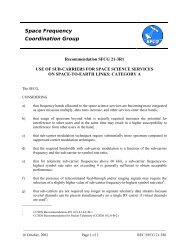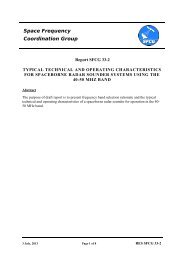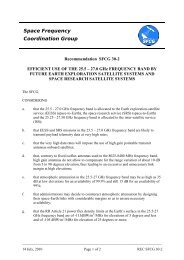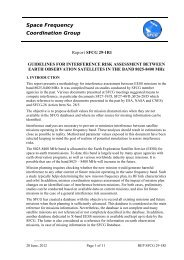Space Frequency Coordination Group - SFCG
Space Frequency Coordination Group - SFCG
Space Frequency Coordination Group - SFCG
You also want an ePaper? Increase the reach of your titles
YUMPU automatically turns print PDFs into web optimized ePapers that Google loves.
<strong>Space</strong> <strong>Frequency</strong><br />
<strong>Coordination</strong> <strong>Group</strong><br />
Recommendation <strong>SFCG</strong> 24-1R1<br />
FREQUENCY ASSIGNMENT GUIDELINES FOR ACTIVE REMOTE<br />
SENSING IN THE MARS REGION<br />
The <strong>SFCG</strong>,<br />
CONSIDERING<br />
a) that concurrent active remote sensors and a regional communication network can be<br />
expected in the foreseeable future at Mars as missions to Mars increase in number and<br />
variety;<br />
b) that frequencies for spaceborne active sensors are provided in the existing allocations to<br />
the space research service (SRS) (active);<br />
c) that frequencies for direct communication between a spacecraft at Mars and an Earth<br />
station are provided in the existing allocations to SRS;<br />
d) that the <strong>SFCG</strong> has resolved to provide assistance to member agencies in coordinating<br />
frequency assignment for communications on deep space missions, including missions to<br />
Mars (see RES <strong>SFCG</strong> A 21-1);<br />
e) that special frequencies may be required for the study of physical characteristics of Mars<br />
and its moons;<br />
f) that in accordance with Resolution <strong>SFCG</strong> 23-5, agencies planning to develop active<br />
remote sensors for use in the Mars region, work together with IUCAF to study issues of<br />
compatibility with radio astronomy observatories in the shielded zone of the Moon;<br />
RECOGNIZING<br />
a) that Mars active remote sensors must not interfere with the direct communication links<br />
between space and the Earth using frequency bands allocated in the ITU Radio<br />
Regulations;<br />
________________________________________________________________________<br />
11 June, 2009 Page 1 of 4 REC <strong>SFCG</strong> 24-1R1
) that Mars active remote sensors also need to avoid interference with frequencies used by<br />
Mars relay networks and other communication equipment in the Mars environment;<br />
RECOMMENDS<br />
1. that agencies select frequencies from Table 1 for active remote sensing in the Mars region<br />
according to the specific applicability and precautions recommended in Table 2;<br />
2. that assignment of Mars active remote sensing frequencies be coordinated within the<br />
<strong>SFCG</strong> in accordance with RES <strong>SFCG</strong> A24-1, with special attention given to ensure<br />
compatibility with communication links in the Mars region.<br />
________________________________________________________________________<br />
11 June, 2009 Page 2 of 4 REC <strong>SFCG</strong> 24-1R1
Table 1: Summary of <strong>Frequency</strong> Bands for Active Remote Sensing in the Mars Region<br />
<strong>Frequency</strong> Band (MHz)<br />
1-6<br />
50-52<br />
125-175*<br />
460-480<br />
1215-1300<br />
2380-2385<br />
3100-3300<br />
5250-5570<br />
8550-8650<br />
9300-9900<br />
13250-13750<br />
17200-17300<br />
35500-36000<br />
78000-79000<br />
94000-94100<br />
*Note: This frequency band will be useful for estimation of dielectric properties of Mars’<br />
moons<br />
________________________________________________________________________<br />
11 June, 2009 Page 3 of 4 REC <strong>SFCG</strong> 24-1R1
Table 2 – Notes on Select Mars Active Sensing and Radiocommunications Links Frequencies<br />
Recommended in Table 1<br />
Active Sensing<br />
Frequencies<br />
Instrument<br />
Adjacent<br />
Radiocommu<br />
nications<br />
Links<br />
allocated in<br />
Rec 22-1R1<br />
Guardband,<br />
Minimum<br />
Separation<br />
between<br />
Bands<br />
Interference Mitigation<br />
460-480 MHz SAR Imager<br />
435-450 MHz<br />
relay<br />
10 MHz Bandwidth to range from 2.5 MHz to 7.5 MHz (as for Mars Eagle) with center<br />
frequency of 465 MHz; sensor band moved to 460-480 MHz for 10 MHz<br />
guardband<br />
2.38-2.385 GHz SAR Imager<br />
2.29-2.3 GHz<br />
relay and<br />
space-to-Earth<br />
80 MHz<br />
Bandwidth about 1 MHz with center frequency of about 2.385 GHz (as for<br />
Magellan ); sensor could move to the right if necessary but stay within allocated<br />
band 2.38-2.385 GHz<br />
8.55 - 8.65 GHz active sensor<br />
8.45-8.50 GHz<br />
relay<br />
50 MHz<br />
Bandwidth for typical SAR about 20 MHz with center frequency of 8.6 GHz;<br />
could move to the right but stay within allocated band 8.55-8.65 GHz<br />
13.25 - 13.75 GHz active sensor<br />
14.5-15.35<br />
GHz relay<br />
750 MHz<br />
Bandwidth for high resolution altimeter around 320 MHz (similar to<br />
TOPEX/JASON) with center frequency of 13.5 GHz; could move to left but stay<br />
within allocated band 13.25-13.75 GHz<br />
35.5 – 36.0 GHz<br />
active sensor,<br />
topographic mapper<br />
34.2-34.7 GHz<br />
Earth-to-<strong>Space</strong><br />
800 MHz<br />
Bandwidth for high resolution altimeter around 320 MHz (similar to<br />
TOPEX/JASON) with center frequency of 35.75 GHz; could move to right but<br />
stay within allocated band 35.5-36.0 GHz; Bandwidth for high resolution<br />
topographic mapper up to 500 MHz with center frequency of 35.75 GHz; if less<br />
than 500 MHz, could move to right but stay within allocated band 35.5-36.0 GHz<br />
________________________________________________________________________<br />
11 June, 2009 Page 4 of 4 REC <strong>SFCG</strong> 24-1R1
















